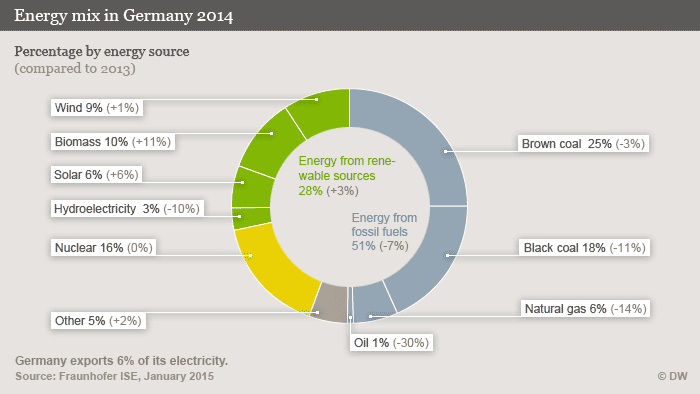The topic of Germany’s energiewende (energy transition) has been hotly debated for years. It is Germany’s effort to wean the public off fossil fuels — most notably coal and petroleum derivatives. The German government has been promoting the use of renewable energy via ‘aggressive’ incentives, and by reducing the ‘soft costs’ associated with installing renewable energy systems. Fortunately, Fraunhofer ISE conducted an analysis on the state of Germany’s energy mix, and discovered that 28% of Germany’s electricity supply is renewable — an increase of 3% since 2013.
Fossil fuels still account for 51% of Germany’s electricity supply, but that has declined by 7% since 2013. It’s important to note that not all fossil fuels are equal, and the same applies to renewable energy sources. Below is a breakdown of the status of each renewable and fossil energy source.
- Brown coal power’s share of Germany’s electricity supply has declined by 3%. It now stands at 25%. Coal is one of the greatest causes of emissions.
- Black coal’s declined by 11%. It now stands at 18%.
- Natural gas’s share (the less smoky alternative to the above) declined by 14%. It now stands at 6%.
- Oil, the moderately smoky fossil fuel declined by an impressive 30%. It now stands at a meagre 1%.
- There was no change for nuclear. Nuclear still provides 16% of Germany’s electricity supply.
As for the renewable sources of energy:
- Wind’s share of Germany’s electricity supply increased by a measly 1%. It now stands at 9%.
- Biomass increased by a noteworthy 11%. It now stands at 10%.
- Solar increased by a noteworthy 6% and also stands at 6%, but faster growth is needed to solve climate change.
- Hydroelectricity declined by 10%, and it now stands at 3%. This is a bit disappointing, as hydroelectric dams are the most adjustable power plants (assuming no energy storage is used), and the rest of the power plants (even the fossil fuelled ones) rely on hydroelectric power plants to respond to sudden changes in electricity supply. They can be adjusted very quickly.
These figures may not be spectacular, but they are among the highest in the world. That is why Germany deserves credit for their energiewende progress. The rest of the world is not taking the climate change situation seriously enough.
Despite this progress, some have claimed that the energiewende increased fossil fuel usage because solar power plants create the need for gas backup (which isn’t true). A few years ago, there was a nuclear phase-out effort in Germany due to the Fukushima Daiichi nuclear disaster which was unresolved for years. This could have caused an increase in fossil fuel usage (if the energiewende opponents are right), but fossil fuel usage in Germany is now following a downward trend.
Another interesting fact the Fraunhofer ISE analysis reveals is: If solar and wind power plants required more fossil fuel energy during manufacture than they could generate (as their opponents claim), these figures wouldn’t be. Fossil fuel usage would have probably increased. Apart from that, it’s important to note that solar panels and wind turbines can (and will) generate the electricity required to manufacture tomorrow’s solar panels and wind turbines, so the argument is moot. The fossil fuel industry went through this process. Fossil-fuelled generators had to be manufactured using fuels which cause emissions. They still are.
Unfortunately, those generators still produce emissions on top of all that, unlike solar panels and wind turbines.
Thanks to Fraunhofer ISE for the research, and for providing the results.









